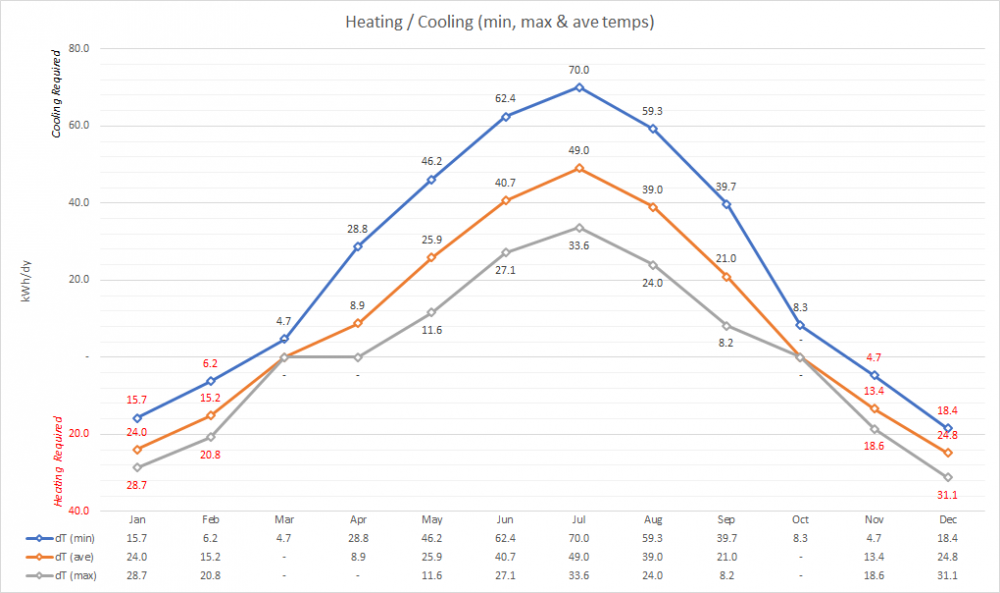Search the Community
Showing results for tags 'cooling'.
-
Hi all, Just come across these.... Capillary Tube Mats - Radiant Heat for Natural Air Conditioning (beka-klima.de) Not big in the UK but seem to have a presence on the continent particularly Germany. Just wondering if anyone has any experience with them? Cant see anything on here from a quick search? Cheers!
-
Another chapter in the renovation saga! (As some people know, we are carrying out a major renovation of a duplex near Paris dating from 1930. Proper cellulose and reflective insulation everywhere, new radiators adapted to low-temperature heating (keeping some of the old ones), ... We already cut off the gas, and are trying to choose an air-water heat pump. We've bought a broken-down courtyard outhouse from the coop so that we can put the "outside" part inside and not bother the neighbors.) We are now inclined towards the Hitachi Yutaki S 2.0 heat-pump, as opposed to the Amzair Optim'Duo, mainly because the company that was going to sell us the Amzair dropped the ball and didn't get back to us with a precise quote. (There's also the fact that the parameters for the Yutaki are somewhat better. It also looked originally as if it was going to be a lot cheaper, but given how much the installer wants to charge us for this and that, I am not sure that this is still true.) Now, the website for the Hitachi Yutaki 2.0 emphatically states that it can also be run backwards, for cooling in the summer. How would that work for an air-to-water heat-pump? Is that only for people who have underfloor heating (I am not one of them)? Or can the heat-pump really cool water (up to what temperature? not clear from the documentation!) that can be simply circulated around the radiators just as one circulates hot water? What measures do I have to take in practice?
-
Keeping a passive house cool
Russdl posted a topic in Energy Efficient & Sustainable Design Concepts
We learnt how to keep our house cool this summer and thought we'd share what we've learnt in case its of use to others. We're in a timber frame building built to the Passivhaus standard but not certified. We don't have an ASHP, so no slab cooling for us but without a doubt our (not so secret) weapon are the external blinds. All our east and south facing windows (with the exception of 3 east facing windows - more on them later) have external blinds and as predicted by the PHPP these are the game changer. Our secret weapon is the little personal weather station (PWS) in the garden and with it's help this is how we've kept the house cool: In the evening when the outside temperature according to the PWS is below our target internal temperature of 21 degrees all doors and windows are opened and the MVHR ramped up. Overnight all the inward tilting windows are left open with the MVHR staying at a higher level and it stays like this until the PWS shows that the external temperature is rising towards our target 21 degrees - that happened at 07:50 this morning. As soon as the exterior temperature reaches our target then all doors and windows are closed and the MVHR is reduced to its lowest setting, we monitor the air quality with a couple of CO2 monitors as recommended by @Adrian Walker and increase the MVHR speed as required to keep good air quality. All sun facing windows have the blinds down, we have the mesh style blinds that don't block off the light but stop lots of UV. With this technique our hallway temperature has peaked in the early evening at around 21-22 degrees and the kitchen/dining room which has lots of east and south facing glazing has stayed below 24 degrees. As soon as we open up we get rid of most of that unwanted heat. The hallway starts in the mornings around 19-20 degrees. The reason I think the PWS is a secret weapon is as far as I'm concerned you need to accurately know the exterior temperature and when to let it in and when to keep it out. On a windy day, 26 degrees can feel cooler than 21 degrees but if you let that stuff in the house you're gonna regret it. If you don't have a PWS you'll probably be able to find one situated close to you on the Weather Underground website. Oh, and the 3 problem east facing windows without external blinds: 1 is the utility room. That has an internal blind and as it's the utility room the internal door to the rest of the house is kept closed. That room gets warm 25-27 degrees but the heat stays in that room which of course has an MVHR extract so the heat is slowly being pumped out of the house until it's door/window opening time then we throw the heat away with vigour. 2 is the ensuite which we deal with in exactly the same way as the utility. 3 is the main bedroom which has a great big window and curtains. The curtains remain closed while the sun is coming in that window but the doors are open so as that room warms up its heat is not being contained in that room. As the sun moves round and that window is no longer in direct sun the curtains are opened and a big old chunk of hot air falls out to be slowly extracted until window opening time. To me, its like the house taking a long overnight gulp of cold air and then holds its breath throughout the day until the temperature is 'just right' again.- 18 replies
-
- 6
-

-
- passivhaus
- overheating
-
(and 2 more)
Tagged with:
-
Following on form the PHPP calls it looks like we'd benefit from some active cooling. I know Jeremy has the Genvex Premium 1 and is very happy with it, but are there any others out there worth considering? The only other that I've seen so far is the Paul/Zehnder one but that's coming out at about £7.5k plus vat - the Genvex Premium 2 that we'd need is about £5k from Denmark and £5.5k from the UK (both plus vat). I'd obviously like to get that down as much as possible if I can
-
Apologies if this is the wrong forum. Am looking at a timber frame (probably) build in the future. Although one requirement will be retaining heat, another one, possibly as important, will be not overheating in the summer. From what I've read then decrement delay can help with this so maybe looking at something like wood fibre insulation or similar. Has anyone experience of this, or designing for it. Alternatively, would you recommend other methods, e.g. MVHR with summer bypass, MVHR with cooling, UFH with cooling, AirCon, solar shades, anything else. Thanks.
- 46 replies
-
- overheating
- cooling
-
(and 1 more)
Tagged with:
-
I found some mention of this in other posts but not my specific question. Now that the hot weather is back I have noticed that on occasion the master bedroom in our current house is a little uncomfortable at around 25C although opening the windows soon fixes this. In the new place the master bedroom has a lot more glass, basically a west facing glazed gable and insulation levels are higher. This got me thinking should I consider "comfort cooling" which I often see advertised on flats in London. I believe that @JSHarris has this on his MVHR, I think via running his heating in reverse? In my case I would have to change the MVHR unit to one that allows cooling. It is partly an attractive option because we will have 3 MVHR units (Dantherm) but one supplies the most used rooms in the house with the most glass so I would only have the extra cost of changing that one unit. I spoke briefly to the heating engineer and he felt it wasn't worth it as there would be an considerable increase in costs because we would have to also up spec the pipework to allow for the possibility of water condensing in it. It would effectively have the same costs as putting in an AC system. He felt that summer bypass is enough, certainly in Scotland it would be rare for the actual outside air temperature to be well above 20C, especially in the evenings. Also we can always open the windows. If this isn't enough he recommended looking at solar reduction film for the windows or a through the wall AC unit. Does anyone have any thoughts or experience of using comfort cooling and how well summer bypass works in practice?
-
UFH pipes go under the floor but, when linked by a ASHP, they can be used for cooling as well as heating, @JSHarris-style. But… air convection works against the cooling effect at the floor. So wouldn't it make sense to put the UFH cooling pipes in the ceiling not under the floor? Or… is the best compromise for both cooling and heating is not put them in the floor or ceiling but in the walls instead? Is this a silly idea? (I thought of this because, in my build, I may not have a concrete slab and have an insulated timber-frame floor instead. It strikes me that it could be just as easy to put the pipes in some of the internal walls as it is it put them on the floor.)
-
This post covers more than just MVHR, but I wasn't quite sure where this post would be best placed. Admins feel free to relocate if need be! As you can probably guess by this post going up late on a Saturday, I've been doing a lot of modelling of our heating and energy systems for our house. It has taken a while to get the model to accurately reflect reality, but I think we've finally nailed it. Whilst not surprising, what it has clearly established is that: PV is a no brainier, provided you have the capital up front! Though that's another topic all together (posted here). The MVHR bypass will be insufficient to counter the solar gain during the peak summer months. It's often said that the biggest problem with passive houses (or near passive as our's is) isn't the heating, but the cooling. They're right! Thankfully we have opening windows and plans to use a canvas above our pergola to shade some of the southern windows. So more our of general curiosity, what else have people done to keep the tempretures stable and comfortable during the summer months?
-
As we have had a few sunny days recently and pretty close to the longest hours of daylight, has anyone suffered increased overheating? Decent temperature data is always welcome, but a general response is also useful.
- 15 replies
-
- sunshine
- over heating
-
(and 4 more)
Tagged with:
-
I was speaking to an engineer today about cooling our house should it need it. He was talking about fan coils when i mentioned cooling the slab with underfloor heating. His advised me not to due to condensation and the risk to the floor and concrete. He stated that it was due to the dew point/humidity in the house and the condensation around the pipes and on the floor. He stated it would form not just on the floor surface but under tiles and around the pipes Now i don't pretend to know anything about this but i am sure that those who have looked into cooling a slab must have considered this issue and mitigated against condensation forming. Can anyone help with this issue(if it is one)
- 21 replies
-
- dew point
- condensation
-
(and 1 more)
Tagged with:
-
With temperatures hitting 25C today this has been the first real test of our house in terms of overheating and how to manage excess heat. When I designed our house, I crunched the numbers, taking into account average and peak daily solar gain. Due to the large amount of SW facing glass that we have, I knew we were going to have some overheating, based on maintaining an internal air temperature of 21C. My number crunching indicated that summer overheating resulting from solar gain could be managed by means of the MVHR summer bypass, and opening a window and ventilating with cooler ambient air, and where appropriate, using blinds or drawing curtains. Up until now, ambient air temperature has always been several degrees lower than internal air temperature making it very easy to control how much of that solar gain we wished to retain. In practice we haven't had to do much in the way of control, as internal temps have not exceeded 23C in the main living areas, the bedrooms remaining 1C cooler as they are on the north side of our site. Today's challenge was how would the house perform without any cool ambient air or active cooling (albeit I do have the capability to cool our slab). I'll be honest and say I was quite concerned, but I'm glad to report that internal temperatures remained lower than external, peaking at 24C in the living areas, 1C cooler in the bedrooms. As ambient air temperature fell to 21C late this afternoon, the summer bypass kicked in and began to ventilate cooler ambient air inside (interestingly, when ambient air was higher than internal, the bypass didn't activate) and I opened two windows, one on the ground floor and the velux on the 1st floor mezzanine to create a natural draw through the house to purge some of the warm air out. This worked brilliantly and rapidly reduced the internal air temperature down to 22C, and shows how effective this method of control is. How did everyone else fare today?
- 38 replies
-
- overheating
- solar gain
-
(and 2 more)
Tagged with:
-
Eventually I might add a conservatory/garden room to my new build dwelling. How can I pre-plumb my UFH circuits so that it is simple to get the UFH into this new area without digging up the floor all the way back to the manifold which will probably be the otherside the house? And related: if I were to put UFH pipework in an outdoor patio area (which could become the floor of the future conservatory) would I be able to: 1. 100% isolate the patio UFH pipework so that it does not lose heat in the winter (before conservatory built) 2. to use the patio UFH to dump any unwanted heat from the remaining UFH circuit to help cool the house (before conservatory built) Thanks










